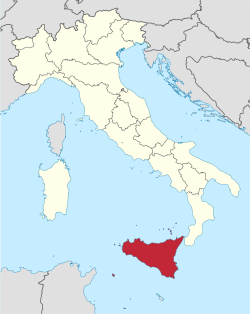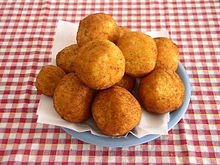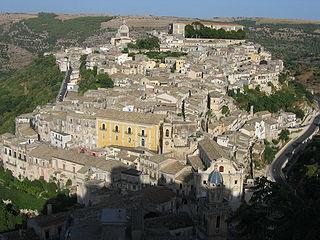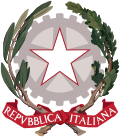| Sicily region | |
| Capital | Palermo |
|---|---|
| Residents | 4.983.478 (2019) |
| surface | 25,711 km² |
| no tourist info on Wikidata: | |
| location | |
 | |
Sicily is the largest island in Mediterranean Sea and belongs to Italy. It's about as big as Belgium. In the north of the island lies the Tyrrhenian Sea, in the east the Ionian and in the south the Mediterranean. In the northeast, Sicily is only 3 km from mainland Italy.
Regions


In terms of administration, Sicily consists of nine provinces:
- Agrigento on the south coast with the provincial capital Agrigento (known from the Valle dei Templi), the port and ceramic city Sciacca and small towns, i.a. Menfi
- Caltanissetta, the province withdraws from the eponymous province Capital to Gela on the south coast
- Catania with the capital Catania and other small towns (Adrano, Bronte and Randazzo on the southern circumference of Mount Etna and the city of ceramics Caltagirone in the hinterland
- Enna with the capital Enna and the city of the Roman mosaic villa Piazza Armerina.
- Messina with the capital, the ferry port Messina on the northeastern tip of Sicily, the historic coastal towns Taormina and Giardini Naxos at the east and Milazzo on the north coast of Sicily
- Palermo: with the island capital Palermo with its ferry and airport, the church of Monreale and the city on the north coast Cefalù
- Ragusa, covers one half of the south-east corner of Sicily, next to the provincial capital Ragusa are the baroque cities Modica, Scicli, Comiso and Vittoria and seaside resorts on the south coast are worth mentioning
- Syracuse includes the southeast of Sicily, next to the provincial capital Syracuse are the baroque cities Noto and Avola as well as the port city Augusta worth a visit
- Trapani at the western tip of Sicily with the provincial capital and port Trapani, the nearby medieval mountain town Erice, the port cities Marsala and Mazara del Vallo on the south coast. In the province are also the Greek temples of Selinunte near Castelvetrano in the south and Segesta in the mountainous hinterland in the north, in the northwest the beaches around San Vito lo Capo.
The autonomous region of Sicily also includes the Aeolian Islands (also Aeolian Islands called), and the Egadi Islands.
places

- 1 Palermo
 (PA), the island's capital with an enormous historical heritage
(PA), the island's capital with an enormous historical heritage - 2 Catania
 (CT), lively port city near Mount Etna
(CT), lively port city near Mount Etna - 3 Messina
 (ME), port city, as the arrival point of the ferry from the mainland one of the gates to Sicily
(ME), port city, as the arrival point of the ferry from the mainland one of the gates to Sicily - 4 Syracuse
 , Siracusa (SR), city on the east coast with Greek roots and an ancient theater
, Siracusa (SR), city on the east coast with Greek roots and an ancient theater
- 5 Agrigento
 , Agrigento (AG), town located on a rocky hill, nearby the imposing Greek temples of the Valle dei Templi
, Agrigento (AG), town located on a rocky hill, nearby the imposing Greek temples of the Valle dei Templi - 6 Caltagirone
 (CT), the "ceramic city"
(CT), the "ceramic city" - 7 Cefalù
 (PA), the town on the north coast is dominated by the Norman cathedral
(PA), the town on the north coast is dominated by the Norman cathedral - 8 Erice
 (TP), medieval town on a rocky hilltop
(TP), medieval town on a rocky hilltop - 9 Ragusa
 (RG), city of the Sicilian Baroque with the historic old town Ibla
(RG), city of the Sicilian Baroque with the historic old town Ibla - 10 Selinunte
 (TP), near the coast, an ancient site with Greek temples
(TP), near the coast, an ancient site with Greek temples - 11 Taormina
 (ME), popular travel destination thanks to the Greek theater on a rocky promontory
(ME), popular travel destination thanks to the Greek theater on a rocky promontory - 12 Trapani
 (TP), port city on the west coast
(TP), port city on the west coast
Other goals
- 1 Aeolian Islands(Aeolian Islands), in the northeast of Sicily. The best way to get there from Milazzo is by hydrofoil.
- 2 Pantelleria, Island between Sicily and Tunisia
- 3 Egadi Islands, Trapani archipelago
background
Sicily is the largest island in the Mediterranean. It was often the plaything of the mighty of its time, due to the eventful history there are many relics from different cultures on the island. Sicily has been part of it since 1860 Italy, but the residents feel like Sicilians first and then Italians. Today Sicily is an autonomous region with its own parliament.
history




The eventful history explains the coexistence of art treasures and architectural monuments from various cultures on the island.
The island of Sicily with its favorable climate was already populated in prehistoric times Sicans, Sikuler and the Elymers in the northwest of the island, who were already adapting to the Greek lifestyle, settled Sicily around 1000 BC.
In the 8th century B.C. began a phase of colonization of the island by Phoenicians resp. of the Carthaginians, which operated from the Phoenician colony Carthage and took the island from the southwest, they fought destructive wars with the Greekswhich around Naxos and Syracuse had gained a foothold on the west coast. Ultimately, the tyrant Dionysius of Syracuse emerged victorious from the conflicts.
In the campaign of the Romans against the Carthaginians residing in the west of Sicily in first punic war came to Sicily with the fall of Syracuse in 212 BC. under Roman rule and remained so until an invasion of the Vandals and Ostrogoths. In the 6th century went after the fall of the Roman Empire, the rule over Sicily to the Byzantines. These were able to the in the 9th Century. not to withstand invading Arabs, Sicily was until the 12th century. under Arab rule.
Around 1060 the conquest of Sicily began at Messina Roger i, the Arab rule over the island fell until 1091, for reasons of inheritance Sicily came under the rule of Friedrich II von Hohenstaufen in 1194. Charles of Anjou was able to seize control of Sicily in 1268, the unpopular French became rulers after the turmoil of the Sicilian Vespers Released in 1282 by the House of Aragon and later by the Burbons, who ruled Sicily for a long time.
The face of the island changed with the mighty one Earthquake in Val di Noto in 1693, several cities in the south-east of Sicily were rebuilt, entire street lines were rebuilt in the style of the Sicilian baroque.
With the landing of the "red shirts" from Garibaldi in 1861 at Marsala and the "March of the Thousand" to Palermo came the end of the Burbon rule and Sicily became part of the Kingdom of Italy. Once again, Sicily was at the focus of history than with the Landing of the Allies on the south coast between Gela and Syracuse in 1943 the end of fascism in Sicily and the defeat of the Axis powers in southern Europe began.
language
In Sicily, Sicilian (an Italian dialect) and Italian are spoken. Communication in English is possible to a limited extent.
getting there
By plane
Sicily is about three major airports - 1 Catania airport(IATA: CTA), 2 Palermo-Punta Raisi Airport(IATA: PMO) and 3 Trapani airport(IATA: TPS) to reach.
All major airlines fly to Sicily from German-speaking countries. These are among others Lufthansa and TUIfly, as well as low-cost airlines like Germanwings, easyJet and Ryanair. Local companies such as Alitalia and the low-cost airline Wind jet.
By train
There are several trains from Rome (travel time around 11-13 hours) and Milan (travel time around 13-16 hours) with direct carriages to Palermo and Catania-Syracuse. These trains have to use the ferries between Villa San Giovanni and Messina, which makes them prone to delays (around 1 hour is more the rule than the exception). Therefore, if an immediate onward journey is planned, a generous time allowance must be included. There are also direct sleeper and couchette cars from Bologna, Genoa, Turin and Venice to Sicily. Most connections do not run daily, the exact traffic times can be found in the timetable information of FS available.
By boat

Various ferry lines operate from the mainland to Sicily: Grandi Navi Veloci (Genoa-Palermo, Civitaveccia-Palermo, Naples-Palermo, Tunis-Palermo and Civitavecchia - Termini Imerese), the SNAV has since merged with GNV. Tirrenia runs from Naples and Cagliari to Palermo and Cagliari-Trapani. TTT Lines serves the Naples-Catania line. Grimaldi Ferries operates on the Salerno-Palermo and Civitaveccia-Trapani, Tunis-Palermo lines.
On the Stretto, the Strait of Messina, car and passenger ferries operate from RFI / Bluvia and Caronte & Tourist almost every hour or at rush hour in the commuter traffic, they can be used without prior reservation, ticket sales on site at the counter.
In the street
The toll on the southbound motorway ends around 100 km south of Naples ![]() A3. South from Salerno goes the
A3. South from Salerno goes the ![]() in the renewed
in the renewed ![]() over, the modernization work was completed in 2016. At least during the season there is constant shuttle traffic between the ferries Villa San Giovanni and Messina. It is not necessary to pre-book tickets, they can be obtained at the counter in the ferry port. The crossing takes about 20 to 30 minutes; the ferries run at least every hour.
over, the modernization work was completed in 2016. At least during the season there is constant shuttle traffic between the ferries Villa San Giovanni and Messina. It is not necessary to pre-book tickets, they can be obtained at the counter in the ferry port. The crossing takes about 20 to 30 minutes; the ferries run at least every hour.
In Sicily are the (again toll) highways ![]() A18 from Messina from up Catania and the
A18 from Messina from up Catania and the ![]() A20 in the direction of Palermo until the end at Buonfornello toll. The
A20 in the direction of Palermo until the end at Buonfornello toll. The ![]() A18 from Messina towards the south was starting Syracuse further expanded and now ends at Rosolini.
A18 from Messina towards the south was starting Syracuse further expanded and now ends at Rosolini.
mobility
The best way to get to Sicily is with the automobile forward, a navigation device is extremely helpful. Even experienced passengers with map experience reach their limits in inner-city areas due to the one-way rules that are not always transparent. Motorhome drivers with large vehicles are advised to park them outside the city center (where possible in a guarded parking lot), as you risk getting stuck in the picturesque maze of alleys in the old towns. Getting around on foot or by bike is frowned upon by the locals outside of town. There are hardly any footpaths or bike paths outside of the villages. However, "combat cyclists" who are probably training for the "Giro d'Italia" can also be expected on the mountain routes in Sicily.
Driving takes some getting used to for foreigners. Traffic is very hectic, especially in the big cities of Palermo, Catania and Messina. Stopping at red traffic lights is not always common, lane changes may only be recognized by honking the horn and then making contact with the fender - if you drive carefully and try to anticipate the intentions of other road users, the traffic will roll smoothly and the Sicilians will give a lot to travelers with foreign license plates. It is worth refraining from the right of way ("I have the right of way, so I drive"), which is familiar from German-speaking countries, but a little "original" can be turned off under the appropriate horn or light signal if you have not caught the branch . More and more Italians attach importance to the impeccable appearance of their "machina", the pictures with the dented rust arbors are becoming increasingly rare.
In the provincial cities it is comparatively easy going, you drive with great attention (what other road users might be planning if they want to overtake despite the safety line ... so I stick hard to the right). On the city motorway of Palermo, there are often four or five lanes in three designated lanes; shared use of the emergency lane to reach the next exit is common in Palermo. However, signposting the exits is a challenge for non-locals - apart from highways and long-distance destinations. The exit from the city motorway in Palermo to Monreale, for example, seldom succeeds on the first attempt.
Parking is generally difficult in cities, the multi-storey car parks and parking lots are often narrow that at least mobile homes cannot find space. Often, at the end of the siesta, before the shops open, parking spaces near the city center are still free. Motorhome owners prefer to leave their vehicle outside, especially in mountain villages, the through-roads can be extremely narrow and angled.
Parking spaces marked in blue are chargeable. Only local cars are allowed to park in yellow-marked parking spaces, if the parking area is marked in white, everyone can park there.
Road types:
Axx - Autostrada - Motorway: partially subject to toll (![]() ,
, ![]() - on this good advancement) that Viacard is not generally accepted, so keep cash ready.
- on this good advancement) that Viacard is not generally accepted, so keep cash ready.
SS - Strada Statale - Expressway in the state-run network: partly multi-lane and increasingly better developed, no toll.
SP - Strada Provinciale - Country roads in the network maintained by the province: especially the older provincial roads with low numbers can be in a precarious condition, while others have the character of an upscale main road.
SR - Strada Regional - In the mountains with two-way traffic, suitable for two Cinquecento, unless a landslide or landslide has destroyed half the lane. Interesting especially after heavy rain in spring
Both public transport a well-developed bus network with affordable prices is available. There are also inexpensive rail connections (low frequency of connections) and taxis.
Tourist Attractions

Probably the biggest attraction of Sicily is the 4 Etna![]() , the most active and largest volcano in Europe. It is located in the northeast of the island, is 3340 m high, and there are small eruptions on a regular basis. The four main craters are located on the summit and around 250 secondary craters are distributed across the mountain. By car or coach you can reach an altitude of 1910 m, where extinct craters can be viewed. Those who want to go further up can take a cable car and jeep up to 2917 m. From there, if the conditions permit, exploration tours with a tourist guide are possible. In winter, Etna offers two winter sports locations for Catania and the surrounding area. The snow covers the summit until April / May and flows on the north side of Mount Etna Alcantara through a beautiful landscape. Over time, the river has cut deeply into the rock and so has the Gola dell 'Alcantara formed a gorge with bizarre rock formations.
, the most active and largest volcano in Europe. It is located in the northeast of the island, is 3340 m high, and there are small eruptions on a regular basis. The four main craters are located on the summit and around 250 secondary craters are distributed across the mountain. By car or coach you can reach an altitude of 1910 m, where extinct craters can be viewed. Those who want to go further up can take a cable car and jeep up to 2917 m. From there, if the conditions permit, exploration tours with a tourist guide are possible. In winter, Etna offers two winter sports locations for Catania and the surrounding area. The snow covers the summit until April / May and flows on the north side of Mount Etna Alcantara through a beautiful landscape. Over time, the river has cut deeply into the rock and so has the Gola dell 'Alcantara formed a gorge with bizarre rock formations.
The cultural sights originate essentially from three epochs, first from the colonization time by the Greeks (places: Selinunte, Segesta, Agrigento), then from the high Middle Ages under Normans and Staufers (Cefalu, Palermo, Monreale) and finally from the baroque (Bagheria, Noto, Ragusa). While the best preserved Greek temples in the world date from the time of the Greeks and the Middle Ages produced a unique synthesis between Romanesque, Byzantine and Islamic art, the Sicilian Baroque can hardly boast any of its own creations.
For self-drive and individual tourists:
- the small, still quite original mountain villages or better "eagle nests" Pollina, San Mauro Castelverde, Sperlinga, Erice,
- The route between is very interesting in terms of landscape Agrigento and Palermo. On the SS118 from Agrigento via Raffadali, Cianciana, Allessandria della Rocca, Santo Stefano Quisquina into the home country of the Mafia implied by film and television. Past or through places like Prizzi, Corleone and Marineothat hardly live up to their reputation. From Bolognetta then continue on the otherwise usual direct connection SS121 past Ficuzza, a good hiking region, towards Palermo.
activities

To the hike The national park regions are particularly suitable.
- http://www.sizilien-netz.de/168/sizilianische-nationalparks.html
- http://www.parks.it/regione.sicilia/index.php
Unfortunately, there are no current topographic maps for Sicily on a scale of 1: 25,000 or 1: 50,000, the black and white maps of the military geographic institute IGM from the 1950s and 1960s are largely out of date. Maps are sometimes available in nature reserves. If in doubt, it is worth taking photos of the maps on the information board at the starting point. A navigation system suitable for hiking helps to determine and extrapolate your own position. (Circular hiking) trails are often marked with constant color markings.
Winter sports is by Etna and possible in the Madonie on Pizzo Carbonara. The inhabitants of Palermo tend to use the Madonie, and Catania has fun in the two areas on Etna. The snow covers the summit until April and May.
- Etna South: Refugio Sapienza Sud valley station (1923 m s.l.m.) at the Silvestri crater, La Montagnola mountain station (2504 m s.l.m.)
- Etna North: The Piano Provenzana on the northeast side of Etna.
kitchen



The Sicilians, like all Italians, do not believe in half measures. Either you are in a hurry and eat your bun standing up in the next bar. Or you go out to eat with the necessary leisure and time.
When visiting a eatery, a flat rate is charged for the place setting and bread (coperto). This can usually also be used to estimate how much effort is put into service.
A real meal consists of:
- starter (antipasto)
- 1st gear (primo piatto), mostly pasta or risotto, sometimes soup (brodo) is served.
- Main course (secondo piatto) Meat or fish dish, whereby the side dishes (contorni) are ordered separately.
- dessert in Sicily mostly sweetness (dolce), at most a fruit (frutta); Cheese (formaggio) is uncommon in Sicily.
After the meal one is allowed to caffè (called espresso in German-speaking countries) are not missing. However, under no circumstances should you order one cappuccino after the meal, because that would be tantamount to insulting the host or host. In Italy, a cappuccino in its large cup is almost an independent meal. You are therefore implying that you have not been satisfied with the previous menu.
If you still don't want to go without your favorite Italian drink, then switch from the Ristorante to the next restaurant after your meal.
nightlife
security
Despite the Mafia cliché, Sicily is no more unsafe than anywhere else in southern Italy. Nevertheless, one should not use the word mafia in public, even if one does not speak Italian at the moment, but rather describe the phenomenon as "organized crime". The mafia is invisible to tourists and usually harmless.
In Sicily is the saying Opportunity makes thieves To be taken literally, especially in the big cities. It is therefore advisable not to leave anything of value in the car, including jewelry, and it is better to keep your handbag in the room. But do not worry, with the necessary caution you have nothing to fear.
climate
Due to the size, the climate is very different. In summer it can get quite cool in the higher elevations inland. The wettest months are February and March.
Average temperatures:
| ° C | J | F. | M. | A. | M. | J | J | A. | S. | O | N | D. | year |
|---|---|---|---|---|---|---|---|---|---|---|---|---|---|
| Catania | 10,1 | 10,4 | 11,9 | 14,1 | 18,0 | 22,2 | 25,3 | 25,6 | 22,9 | 18,7 | 14,4 | 11,2 | 17,1 |
| Enna | 4,7 | 5,0 | 6,5 | 9,2 | 14,3 | 19,1 | 21,9 | 22,2 | 18,5 | 13,4 | 9,6 | 6,4 | 12,6 |
| I. Ustica | 10,5 | 10,5 | 11,5 | 13,3 | 16,9 | 20,9 | 23,8 | 24,5 | 22,3 | 18,4 | 14,9 | 12,0 | 16,6 |
| Messina | 11,8 | 11,8 | 13,0 | 15,0 | 18,7 | 22,8 | 25,8 | 26,2 | 23,7 | 19,8 | 16,2 | 13,5 | 18,2 |
| Palermo | 11,6 | 11,9 | 13,4 | 15,7 | 18,9 | 22,6 | 25,2 | 25,4 | 23,6 | 20,1 | 16,7 | 13,2 | 18,2 |
For Central Europeans who are not completely used to the heat, April - June and September are probably the best months to travel, the temperatures are then often a pleasant 25 ° and sights and excursions can be visited without excessive sweating. In midsummer the temperatures in the south of Sicily can reach 35 - 40 ° in the shade.
trips
literature
- : Sicily DuMont Art Travel Guide. DuMont travel publisher, 2010 (6th edition), ISBN 9783770143856 .
- : History of Sicily and the Sicilians. Munich: C. H. Beck, 2006, ISBN 3406541305 .
- : Sicily. Cologne: DuMont book publisher, 2001 (5th edition), ISBN 3-7701-3476-1 .
- Polyglot APA Guide Sicily. Berlin and Munich: Langenscheidt KG, 2005, ISBN 3-8268-1919-5 .
- : Sicily. A literary landscape picture. Frankfurt am Main: Insel Verlag, 2000, ISBN 3-458-34337-7 .
- : Sicily, Egadi, Pelagie & Aeolian Islands. Bielefeld: Reise-Know-How-Verlag Peter Rump, 2005, ISBN 3-8317-1352-9 .
- : Sicily. Michael Müller Publishing House, 2010 (7th edition), ISBN 978-3-89953-551-8 .
- Sicily. Touring Club Italiano, ISBN 88-365-3402-3 .
- : The leopard. Munich: Piper, 2006 (22nd edition), ISBN 978-3-492-20320-3 ; Novel.










.JPG/350px-Sicily_Selinunte_Temple_E_(Hera).JPG)







.jpg/320px-Trapani-Birgi_Airport_(1).jpg)
.jpg/320px-View_of_Mount_Etna_from_Reggio_Calabria_-_Italy_-_10_Feb._2017_-_(1).jpg)
